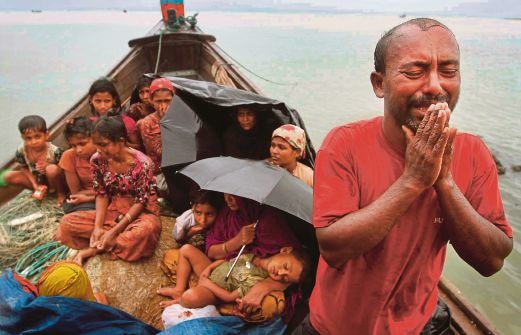It is almost a year to the climax of last year’s Rohingya refugee crisis, the aftermath of a crackdown by Thai authorities on land-smuggling routes that led to the surge of boats packed with Rohingya and Bangladeshi refugees and economic migrants crossing the Andaman Sea. Many, if not all, were sailing for Malaysia.
Readers will remember the gripping headlines and even more gripping photos and videos of desperate, emaciated individuals on rickety boats, in some cases abandoned by their smugglers, begging for food, water and shelter.
Policymakers feared being “swarmed” and Thai, Indonesian and Malaysian navies were involved in “human ping-pong pushbacks” of refugee boats.
Individuals, non-governmental organisations and fishermen took it upon themselves to seek out boats and provide help.
There was also criticism by international organisations of the initial reluctance of the three countries to accept refugees.
Overall, it made for a tragic yet riveting media circus.
The boats and media attention may have temporarily stopped, although an undetermined number of migrants still cross overland from Thailand.
Regional governments and international organisations are working to provide for the displaced as best they can while efforts are ongoing to strengthen regional frameworks to better prepare for future displacement crises.
Things seemed more or less settled, relatively speaking.
Nevertheless, it is important that Malaysians — not just the policy makers, observers and scholars, but the people — take heed of the tragedy befalling Rohingyas, because it involves Malaysia.
The following are three reasons why, as Malaysians, we should care and why the fate of the Rohingyas is important to Malaysia.
First, they are here and have been so for some time. Rohingyas are a visible and significant part of undocumented migrants in Malaysia.
They reside in Malaysia, with larger communities in and around Kuala Lumpur, and in other states such as Penang, Johor, Kedah, Kelantan and Terengganu.
Many have been here for years and generations, are well versed in Malaysian customs and the national language.
Numbers from the United Nations High Commissioner for Refugees (UNHCR) indicate there are at least 40,000 Rohingyas in Malaysia.
An increasing number are families who fled violence in Rakhine state.
A 2014 report indicated that nearly a quarter of Rohingyas in Malaysia are children.
There are thousands more that the UNHCR, local aid organisations and the authorities know nothing about.
They play a part in Malaysia’s informal economy that depends heavily on cheap labour that locals shun. Many, especially women and children, beg at traffic lights and walkways.
Second, more are (probably) coming. For most Rohingyas fleeing for political or economic reasons, Malaysia is a destination of choice both in the short term and for long-term settlement.
Few have taken up offers to be resettled in the West.
There are many reasons for this. They include Malaysia being a relatively close, peaceful and prosperous country, Malaysia’s dependence on cheap labour, having family and communities present and a belief that they would be welcomed as fellow Muslims and can integrate easily.
Many of the nearly two million Rohingyas in Myanmar and Bangladesh, living in desperate conditions, are willing to risk their lives to reach Malaysia. They are not interested in heading or settling elsewhere in the region.
Knowing this, neighbouring countries have been known to help on boats destined to Malaysia, not wanting to deal with the responsibilities and cost of detaining them.
Third, concern for and finding a solution to the plight of Rohingyas is the right thing to do.
The violence and displacement aren’t happening in a faraway corner of the world. This is happening in our backyard.
Their persecution and displacement is a sensitive, sore and disconcerting point for Asean, especially as it moves forward as a Community.
Yet, there appears to be little it can do.
Even usage of the term Rohingya is contested in official meetings.
As a founding nation and responsible member of Asean, Malaysians should be aware of key socio-political-economic issues impacting other Asean members, especially with such humanitarian dimensions.
One should note that this isn’t Malaysia’s first post-independence experience with the mass arrival of undocumented migrants or refugees.
For the past 40 years, Malaysia has become a destination for refugees to seek either temporary or permanent refuge, although it is not a party to the 1951 Refugee Convention and its 1967 Protocol.
Prior arrivals included southern Filipinos from Mindanao during the late 1970s and early 1980s, Cambodian and Vietnamese during the same period, a small number of Bosnian refugees in the early 1990s, and Indonesians from Aceh later on.
In most cases, they are eventually returned to their countries of origin, or resettled to third, mainly Western countries.
In most cases, Malaysia, along with other countries, worked towards finding a political solution at the source of the refugee flow.
In the case of southern Filipinos however, many have settled in Sabah. This has contributed to the complex ethnic, religious, political, social, economic and even security situation there today.
As a nation, Malaysia is undergoing the process of nation building and managing religious-ethnic relations.
An influx of a new ethnic group, especially in large numbers, will have significant and longstanding socio-cultural, economic, security and political implications to the future make-up of Malaysia.
This article first appeared in The New Straits Times 26 April 2016





